 |
RENAISSANCE ARCHITECTURE IN FRANCE:THE TRANSITION, CHURCHES |
| << RENAISSANCE ARCHITECTURE IN ITALY—Continued:BRAMANTE’S WORKS |
| RENAISSANCE ARCHITECTURE IN GREAT BRITAIN AND THE NETHERLANDS >> |
CHAPTER
XXII.
RENAISSANCE
ARCHITECTURE IN FRANCE.
BOOKS RECOMMENDED: As before, Fergusson, M�ntz,
Palustre. Also Berty,
La
Renaissance
monumentale en France.
Ch�teau, Histoire
et caract�res de
l'architecture
en
France.
Daly, Motifs
historiques d'architecture et de
sculpture. De
Laborde, La
Renaissance
des arts � la cour de
France. Du
Cerceau, Les
plus excellents bastiments
de
France.
L�bke, Geschichte
der Renaissance in
Frankreich.
Mathews, The
Renaissance
under
the Valois Kings.
Palustre, La
Renaissance en France.
Pattison, The
Renaissance
of
the Fine Arts in
France.
Rouyer et Darcel, L'Art
architectural en France.
Sauvageot,
Choix
de palais, ch�teaux, h�tels, et
maisons de France.
ORIGIN
AND CHARACTER. The vitality
and richness of the Gothic style in
France,
even
in its decline in the fifteenth century,
long stood in the way of any
general
introduction
of classic forms. When the Renaissance
appeared, it came as a
foreign
importation,
introduced from Italy by the king and the nobility. It
underwent a
protracted
transitional phase, during which the
national Gothic forms and
traditions
were
picturesquely mingled with those of the
Renaissance. The campaigns of
Charles
VIII.
(1489), Louis XII. (1499), and Francis I. (1515), in
vindication of their
claims
to
the thrones of Naples and Milan, brought
these monarchs and their nobles
into
contact
with the splendid material and artistic
civilization of Italy, then in the full
tide
of the maturing Renaissance. They
returned to France, filled with the
ambition
to
rival the splendid palaces and gardens of
Italy, taking with them Italian artists
to
teach
their arts to the French. But while these
Italians successfully introduced
many
classic
elements and details into French
architecture, they wholly failed to
dominate
the
French master-masons and tailleurs
de pierre in
matters of planning and
general
composition.
The early Renaissance architecture of
France is consequently wholly
unlike
the Italian, from which it derived only minor
details and a certain
largeness
and
breadth of spirit.
PERIODS.
The
French Renaissance and its
sequent developments may be
broadly
divided
into three periods, with subdivisions
coinciding more or less
closely with
various
reigns, as follows:
I.
THE VALOIS PERIOD, or Renaissance proper, 14831589,
subdivided into:
a.
THE TRANSITION,
comprising the reigns of Charles VIII.
and Louis XII. (1483
1515),
and the early years of that of Francis
I.; characterized by a picturesque
mixture
of classic details with Gothic
conceptions.
b.
THE STYLE OF FRANCIS I.,
or Early Renaissance, from about 1520 to
that king's
death
in 1547; distinguished by a remarkable
variety and grace of composition
and
beauty
of detail.
c.
THE ADVANCED RENAISSANCE, comprising the
reigns of Henry II. (1547), Francis
II.
(1559),
Charles IX. (1560), and Henry III. (157489);
marked by the gradual
adoption
of the classic orders and a decline in
the delicacy and richness of the
ornament.
II.
THE BOURBON OR CLASSIC PERIOD (15891715):
a.
STYLE OF HENRY IV., covering his reign and
partly that of Louis XIII. (161045),
employing
the orders and other classic
forms with a somewhat heavy, florid
style of
ornament.
b.
STYLE OF LOUIS XIV., beginning in the preceding
reign and extending through that
of
Louis XIV. (16451715); the great age of
classic architecture in
France,
corresponding
to the Palladian in Italy.
III.
THE DECLINE OR ROCOCO PERIOD,
corresponding with the reign of Louis
XV.
(171574);
marked by pompous extravagance and
capriciousness.
During
this period a reaction set in
toward a severer classicism,
leading to the styles
of
Louis XVI. and of the Empire, to be
treated of in a later
chapter.
THE
TRANSITION. As
early as 1475 the new style made
its appearance in
altars,
tombs,
and rood-screens wrought by French
carvers with the collaboration of
Italian
artificers.
The tomb erected by Charles of Anjou to
his father in Le Mans
cathedral
(1475,
by Francesco
Laurana), the
chapel of St. Lazare in the
cathedral of Marseilles
(1483),
and the tomb of the children of Charles VIII. in Tours
cathedral (1506), by
Michel
Columbe, the
greatest artist of his time
in France, are examples. The
schools
of
Rouen and Tours were especially
prominent in works of this kind, marked
by
exuberant
fancy and great delicacy of
execution. In church architecture
Gothic
traditions
were long dominant, in spite
of the great numbers of Italian prelates
in
France.
It was in ch�teaux,
palaces, and dwellings that the new style
achieved its
most
notable triumphs.
EARLY
CH�TEAUX. The
castle of Charles VIII., at Amboise on
the Loire, shows
little
trace of Italian influence. It was under
Louis XII. that the transformation
of
French
architecture really began. The
Ch�teau
de Gaillon (of
which unfortunately
only
fragments remain in the �cole
des Beaux-Arts at Paris), built for the
Cardinal
George
of Amboise, between 1497 and 1509, by
Pierre
Fain,
was the masterwork of
the
Rouen school. It presented a
curious mixture of styles, with its
irregular plan, its
moat,
drawbridge, and round corner-towers, its
high roofs, turrets, and
dormers,
which
gave it, in spite of many Renaissance
details, a medi�val picturesqueness.
The
Ch�teau
de Blois (the
east and south wings of the
present group), begun for
Louis
XII.
about 1500, was the first of a
remarkable series of royal
palaces which are the
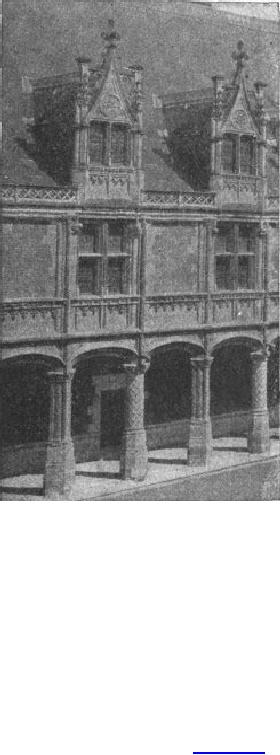
glory
of French architecture. It shows the new
influences in its horizontal
lines and
flat,
unbroken fa�ades of brick and
stone, rather than in its
architectural details
(Fig.
175).
The Ducal
Palace at Nancy and
the H�tel
de Ville at
Orl�ans, by Viart, show
a
similar
commingling of the classic and medi�val
styles.
FIG.
175.--BLOIS, COURT FA�ADE OF
WING OF LOUIS XII.
STYLE
OF FRANCIS I. Early
in the reign of this monarch, and partly under the
lead
of
Italian artists, like il Rosso,
Serlio, and Primaticcio, classic
elements began to
dominate
the general composition and Gothic
details rapidly disappeared. A
simple
and
effective system of exterior
design was adopted in the
castles and palaces of this
period.
Finely moulded belt-courses at the
sills and heads of the windows marked
the
different
stories, and were crossed by a
system of almost equally
important vertical
lines,
formed by superposed pilasters
flanking the windows continuously
from
basement
to roof. The fa�ade was
crowned by a slight cornice and
open balustrade,
above
which rose a steep and lofty roof,
diversified by elaborate dormer
windows
like
long panels ornamented with
arabesques of great beauty, or with a
species of
baluster
shaft like a candelabrum,
were preferred to columns, and
were provided
with
graceful capitals of the Corinthianesque
type. The mouldings were minute
and
richly
carved; pediments were
replaced by steep gables, and
mullioned windows with
stone
crossbars were used in
preference to the simpler Italian
openings. In the earlier
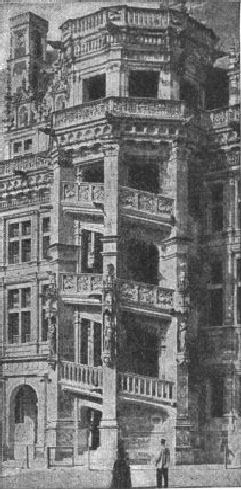
monuments
Gothic details were still
used occasionally; and round
corner-towers,
high
dormers, and numerous turrets and
pinnacles appear even in the
ch�teaux of
later
date.
CHURCHES.
Ecclesiastical
architecture received but scant
attention under Francis I.,
and,
so far as it was practised, still
clung tenaciously to Gothic
principles. Among the
few
important churches of this period may be
mentioned St.
Etienne du Mont,
at
Paris
(151738), in which classic and Gothic
features appear in nearly
equal
proportions;
the east end of St.
Pierre, at
Caen, with rich external carving; and
the
great
parish church of St.
Eustache, at
Paris (1532, by Lemercier), in which
the plan
and
construction are purely Gothic, while the
details throughout belong to the
new
style,
though with little appreciation of the spirit and
proportions of classic art. New
fa�ades
were also built for a number of already
existing churches, among which
St.
Michel, at Dijon, is
conspicuous, with its vast
portal arch and imposing
towers. The
Gothic
towers of Tours cathedral were
completed with Renaissance lanterns
or
belfries,
the northern in 1507, the southern in 1547.
FIG.
176.--STAIRCASE TOWER,
BLOIS.
PALACES.
To the
palace at Blois begun by his
predecessor, Francis I. added
a
northern
and a western wing, completing the court.
The north wing is one of the
masterpieces
of the style, presenting toward the court
a simple and effective
composition,
with a rich but slightly projecting
cornice and a high roof with
elaborate
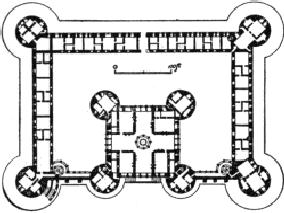
dormers.
This fa�ade is divided into two
unequal sections by the open
Staircase
Tower
(Fig.
176), a chef-d'oeuvre
in
boldness of construction as well as in
delicacy
and
richness of carving. The outer
fa�ade of this wing is a less ornate but
more
vigorous
design, crowned by a continuous
open loggia under the roof. More
extensive
than
Blois was Fontainebleau, the
favorite residence of the king and of
many of his
successors.
Following in parts the irregular plan of
the convent it replaced, its
other
portions
were more symmetrically
disposed, while the whole was treated
externally
in
a somewhat severe, semi-classic
style, singularly lacking in
ornament. Internally,
however,
this palace, begun in 1528 by Gilles
Le Breton,
was at that time the
most
splendid
in France, the gallery of Francis I.
being especially noted. The
Ch�teau
of
St.
Germain,
near Paris (1539, by Pierre
Chambiges), is of a
very different character.
Built
largely of brick, with flat balustraded
roof and deep buttresses
carrying three
ranges
of arches, it is neither Gothic nor
classic, neither fortress nor
palace in aspect,
but
a wholly unique conception.
FIG.
177.--PLAN OF CHAMBORD.
The
rural ch�teaux and hunting-lodges erected
by Francis I. display the
greatest
diversity
of plan and treatment, attesting the
inventiveness of the French
genius,
expressing
itself in a new-found language,
whose formal canons it
disdained. Chief
among
them is the Ch�teau
of Chambord (Figs.
177, 178)--"a Fata Morgana in the
midst
of a wild, woody thicket," to use L�bke's
language. This extraordinary
edifice,
resembling
in plan a feudal castle with
curtain-walls, bastions, moat, and
donjon, is
in
its architectural treatment a
palace with arcades, open-stair
towers, a noble
double
spiral
staircase terminating in a graceful
lantern, and a roof of the most
bewildering
complexity
of towers, chimneys, and dormers (1526,
by Pierre
le Nepveu).
The
hunting-lodges
of La Muette and Chalvau, and the so-called
Ch�teau
de Madrid--all
three
demolished during or since the
Revolution--deserve mention, especially
the
last.
This consisted of two rectangular
pavilions, connected by a lofty
banquet-hall,
and
adorned externally with arcades in
Florentine style, and with medallions
and
reliefs
of della Robbia ware (1527, by
Gadyer).
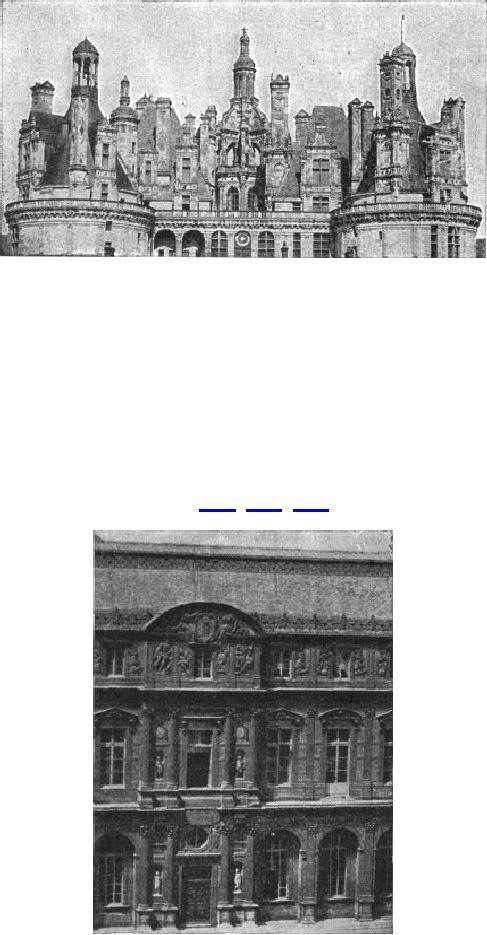
FIG.
178.--VIEW OF CHAMBORD.
THE
LOUVRE. By far the
most important of all the architectural
enterprises of this
reign,
in ultimate results, if not in original
extent, was the beginning of a new
palace
to
replace the old Gothic fortified
palace of the Louvre. To this task
Pierre Lescot was
summoned
in 1542, and the work of erection actually
begun in 1546. The new
palace,
in a sumptuous and remarkably dignified
classic style, was to have
covered
precisely
the area of the demolished fortress. Only
the southwest half, comprising
two
sides of the court, was,
however, undertaken at the outset
(Fig. 179). It
remained
for later monarchs to amplify the
original scheme, and ultimately
to
complete,
late in the present century, the most
extensive and beautiful of all the
FIG.
179.--DETAIL OF COURT OF LOUVRE,
PARIS.
Want
of space forbids more than a
passing reference to the rural castles of
the
nobility,
rivalling those of the king.
Among them Bury, La Rochefoucauld,
Bournazel,
and
especially Azay-le-Rideau
(1520) and
Chenonceaux
(151523),
may be
mentioned,
all displaying that love of rural
pleasure, that hatred of the city and
its
confinement,
which so distinguish the French from the Italian
Renaissance.
OTHER
BUILDINGS. The
H�tel-de-Ville
(town
hall), of Paris, begun
during this
reign,
from plans by Domenico
di Cortona (?),
and completed under Henry IV., was
the
most important edifice of a
class which in later periods
numbered many
interesting
structures. The town hall of Beaugency
(1527) is
one of the best of minor
public
buildings in France, and in its
elegant treatment of a simple
two-storied fa�ade
may
be classed with the Maison
Fran�ois I., at
Paris. This stood formerly
at Moret,
whence
it was transported to Paris and
re-erected about 1830 in somewhat
modified
form.
The large city houses of this period
are legion; we can mention
only the H�tel
Carnavalet
at Paris; the H�tel Bourgtheroude at
Rouen; the H�tel d'�coville at
Caen;
the
archbishop's palace at Sens, and a number
of houses in Orl�ans. The Tomb
of
Louis
XII., at
St. Denis, deserves especial
mention for its fine
proportions and
beautiful
arabesques.
THE
ADVANCED RENAISSANCE. By the
middle of the sixteenth century the
new
style
had lost much of its earlier
charm. The orders, used with
increasing frequency,
were
more and more conformed to
antique precedents. Fa�ades
were flatter and
simpler,
cornices more pronounced,
arches more Roman in
treatment, and a heavier
style
of carving took the place of the
delicate arabesques of the preceding
age. The
reigns
of Henry II. (154759) and Charles IX. (156074)
were especially
distinguished
by the labors of three celebrated
architects: Pierre
Lescot (151578),
who
continued the work on the southwest angle
of the Louvre; Jean
Bullant (1515
78),
to whom are due the right wing of Ecouen
and the porch of colossal
Corinthian
columns
in the left wing of the same, built under Francis I.;
and, finally, Philibert
de
l'Orme
(151570).
Jean
Goujon (151072)
also executed during this
period most of
the
remarkable architectural sculptures which
have made his name
one of the most
illustrious
in the annals of French art. Chief
among the works of de l'Orme was
the
palace
of the Tuileries, built under
Charles IX. for Cath�rine de M�dicis, not
far from
the
Louvre, with which it was ultimately
connected by a long gallery. Of the
vast
plan
conceived for this palace, and comprising
a succession of courts and wings,
only
a
part of one side was erected
(156472). This consisted of a
domical pavilion,
flanked
by low wings only a story and a half
high, to which were added two
stories
under
Henry IV., to the great advantage of the
design. Another masterpiece
was the
Ch�teau
d'Anet, built in
1552 by Henry II. for Diane de Poitiers, of
which,
unfortunately,
only fragments survive. This
beautiful edifice, while retaining
the
semi-military
moat and bastions of feudal
tradition, was planned with
classic
symmetry,
adorned with superposed orders, court
arcades, and rectangular
corner-
pavilions,
and provided with a domical cruciform
chapel, the earliest of its
class in
France.
All the details were unusually pure and
correct, with just enough of
freedom
and
variety to lend a charm wanting in
later works of the period. To the
reign of
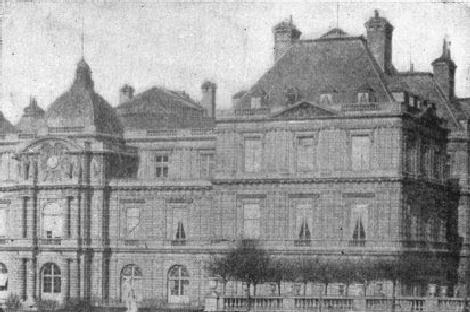
Henry
II. belong also the ch�teaux of
Ancy-le-Franc, Verneuil, Chantilly
(the "petit
ch�teau,"
by Bullant), the banquet-hall over the
bridge at Chenonceaux (1556),
several
notable residences at Toulouse, and the
tomb of Francis I. at St. Denis.
The
ch�teaux
of Pailly
and
Sully,
distinguished by the sobriety and
monumental quality
of
their composition, in which the orders
are important elements,
belong to the reign
of
Charles IX., together with the Tuileries,
already mentioned.
FIG.
180.--THE LUXEMBURG,
PARIS.
THE
CLASSIC PERIOD: HENRY IV. Under this
energetic but capricious
monarch
(15891610)
and his Florentine queen,
Marie de M�dicis, architecture
entered upon
a
new period of activity and a new stage of
development. Without the charm of
the
early
Renaissance or the stateliness of the age of
Louis XIV., it has a touch of the
Baroque,
attributable partly to the influence of
Marie de M�dicis and her Italian
prelates,
and partly to the Italian training of many of the
French architects. The
great
work
of this period was the extension of the
Tuileries by J.
B. du Cerceau, and
the
completion,
by M�t�zeau
and
others, of the long gallery next the
Seine, begun under
Henry
II., with the view of connecting the Tuileries with
the Louvre. In this part of
the
work colossal orders were
used with indifferent effect. Next in
importance was
the
addition to Fontainebleau of a great
court to the eastward, whose
relatively quiet
and
dignified style offers less
contrast than one might expect to the
other wings and
courts
dating from Francis I. More successful
architecturally than either of the
above
was
the Luxemburg
palace,
built for the queen by Salomon
De Brosse, in 1616
(Fig.
180).
Its plan presents the favorite French
arrangement of a main building
separated
from
the street by a garden or court, the
latter surrounded on three
sides by low
wings
containing the dependencies. Externally,
rusticated orders recall the
garden
front
of the Pitti at Florence; but the scale
is smaller, and the projecting
pavilions
and
high roofs give it a grace and
picturesqueness wanting in the Florentine
model.
The
Place
Royale, at
Paris, and the ch�teau of Beaumesnil,
illustrate a type of
brick-
and-stone
architecture much in vogue at this time,
stone quoins decorating
the
windows
and corners, and the orders being
generally omitted.
Under
Louis XIII. the Tuileries were
extended northward and the Louvre as built
by
Lescot
was doubled in size by the
architect Lemercier, the
Pavillon de l'Horloge
being
added
to form the centre of the enlarged court
fa�ade.
CHURCHES.
To this
reign belong also the most
important churches of the
period.
The
church of St.
Paul-St. Louis, at
Paris (1627, by Derrand),
displays the worst
faults
of the time, in the overloaded and
meaningless decoration of its
uninteresting
front.
Its internal dome is the earliest in
Paris. Far superior was the
chapel of the
Sorbonne, a
well-designed domical church by Lemercier, with a
sober and
appropriate
exterior treated with superposed
orders.
PERIOD
OF LOUIS XIV. This
was an age of remarkable literary and
artistic activity,
pompous
and pedantic in many of its
manifestations, but distinguished also
by
productions
of a very high order. Although
contemporary with the Italian
Baroque--
Bernini
having been the guest of
Louis XIV.--the architecture of this
period was free
from
the wild extravagances of that style. In
its often cold and correct
dignity it
resembled
rather that of Palladio, making
large use of the orders in
exterior design,
and
tending rather to monotony than to
overloaded decoration. In interior
design
there
was more of lightness and
caprice. Papier-mach� and stucco
were freely used in
a
fanciful style of relief
ornamentation by scrolls, wreaths,
shells, etc., and
decorative
panelling
was much employed. The whole was
saved from triviality only by the
controlling
lines of the architecture which framed
it. But it was better suited
to
cabinet-work
or to the prettinesses of the boudoir than to
monumental interiors. The
Galerie
d'Apollon, built
during this reign over the
Petite Galerie in the
Louvre,
escapes
this reproach, however, by the sumptuous
dignity of its interior
treatment.
VERSAILLES.
This
immense edifice, built about an
already existing villa of
Louis
XIII.,
was the work of Levau
and
J.
H. Mansart (16471708).
Its erection, with the
laying
out of its marvellous park,
almost exhausted the resources of the
realm, but
with
results quite incommensurate with the
outlay. In spite of its vastness,
its
exterior
is commonplace; the orders are
used with singular monotony, which is
not
redeemed
by the deep breaks and projections of the
main front. There is no
controlling
or dominant feature; there is no
adequate entrance or approach; the
grand
staircases
are badly placed and unworthily
treated, and the different elements of
the
plan
are combined with singular
lack of the usual French
sense of monumental and
rational
arrangement. The chapel is by far the
best single feature in the
design.
Far
more successful was the
completion of the Louvre, in 1688, from the
designs of
Claude
Perrault, the court
physician, whose plans were
fortunately adopted in
preference
to those of Bernini. For the
east front he designed a
magnificent
Corinthian
colonnade nearly 600 feet
long, with coupled columns upon a
plain high
basement,
and with a central pediment and terminal
pavilions (Fig. 181). The whole
forms
one of the most imposing
fa�ades in existence; but it is a mere
decoration,
having
no practical relation to the building
behind it. Its height required the
addition
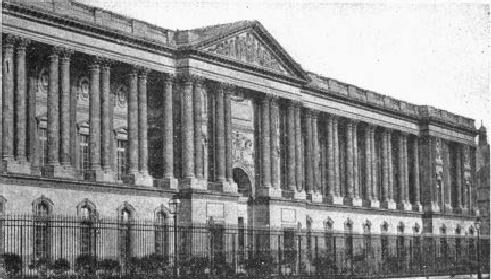
of
a third story to match it on the north and
south sides of the court, which as
thus
completed
quadrupled the original area
proposed by Lescot. Fortunately the
style of
Lescot's
work was retained throughout in the court
fa�ades, while externally the
colonnade
was recalled on the south front by a
colossal order of pilasters. The
Louvre
as
completed by Louis XIV. was a
stately and noble palace, as
remarkable for the
surpassing
excellence of the sculptures of Jean
Goujon as for the dignity and
beauty
of
its architecture. Taken in connection
with the Tuileries, it was unrivalled by
any
palace
in Europe except the
Vatican.
FIG.
181.--COLONNADE OF LOUVRE.
OTHER
BUILDINGS. To
Louis XIV. is also due the
vast but uninteresting H�tel
des
Invalides
or
veteran's asylum, at Paris, by J. H.
Mansart. To the chapel of this
institution
was added, in 16801706, the
celebrated Dome
of the
Invalides,
a
masterpiece by the same architect. In
plan it somewhat resembles
Bramante's
scheme
for St. Peter's--a Greek
cross with domical chapels in the four
angles and a
dome
over the centre. The exterior
(Fig. 182), with the lofty gilded dome on
a high
drum
adorned with engaged columns, is
somewhat high for its breadth, but is
a
harmonious
and impressive design; and the interior,
if somewhat cold, is elegant
and
well
proportioned. The chief innovation in the
design was the wide
separation of the
interior
stone dome from the lofty exterior
decorative cupola and lantern of
wood,
this
separation being designed to
meet the conflicting demands of
internal and
external
effect. To the same architect is
due the formal monotony of the Place
Vend�me, all the
houses surrounding it being
treated with a uniform architecture
of
colossal
pilasters, at once monumental and
inappropriate. One of the most
pleasing
designs
of the time is the Ch�teau
de Maisons (1658), by
F.
Mansart,
uncle of J. H.
Mansart.
In this the proportions of the central and
terminal pavilions, the mass
and
lines
of the steep roof �
la Mansarde, the
simple and effective use of the
orders, and
the
refinement of all the details impart a
grace of aspect rare in
contemporary works.
The
same qualities appear also
in the Val-de-Gr�ce, by F.
Mansart and Lemercier,
a
domical church of excellent proportions
begun under Louis XIII. The want of
space
forbids
mention of other buildings of this
period.
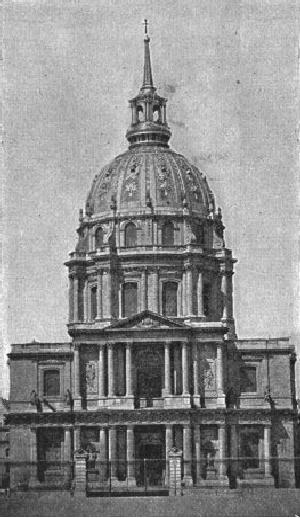
FIG.
182.--DOME OF THE INVALIDES.
THE
DECLINE. Under
Louis XV. the pedantry of the classic
period gave place to
a
protracted
struggle between license and the
severest classical correctness.
The
exterior
designs of this time were
often even more
uninteresting and bare than under
Louis
XIV.; while, on the other hand, interior
decoration tended to the extreme
of
extravagance
and disregard of constructive propriety.
Contorted lines and
crowded
scrolls,
shells, and palm-leaves adorned the
mantelpieces, cornices, and ceilings,
to
the
almost complete suppression of
straight lines.
While
these tendencies prevailed in many
directions, a counter-current of
severe
classicism
manifested itself in the designs of a
number of important public
buildings,
in
which it was sought to copy the
grandeur of the old Roman colonnades
and
arcades.
The important church of St.
Sulpice at
Paris (Fig. 183) is an
excellent
example
of this. Its interior, dating from the
preceding century, is well designed,
but
in
no wise a remarkable composition,
following Italian models. The fa�ade,
added in
1755
by Servandoni,
is, on the other hand, one of the
most striking
architectural
objects
in the city. It is a correct and well proportioned
classic composition in two
stories--an
Ionic arcade over a Doric
colonnade, surmounted by two lateral
turrets.
Other
monuments of this classic revival will be
noticed in Chapter XXV.
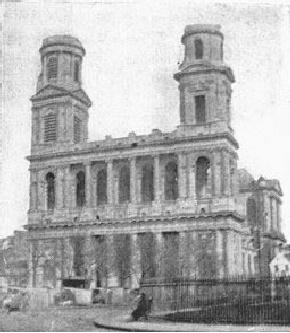
FIG.
183.--FA�ADE OF ST. SULPICE,
PARIS.
PUBLIC
SQUARES. Much
attention was given to the
embellishment of open
spaces
in
the cities, for which the classic style
was admirably suited. The
most important
work
of this kind was that on the north side of the
Place de la Concorde, Paris.
This
splendid
square, perhaps, on the whole, the
finest in Europe (though many of
its best
features
belong to a later date), was
at this time adorned with the two
monumental
colonnades
by Gabriel.
These colonnades, which form the
decorative fronts for
blocks
of
houses, deserve praise for the
beauty of their proportions, as well as for
the
excellent
treatment of the arcade on which they
rest, and of the pavilions at the
ends.
IN
GENERAL. French
Renaissance architecture is marked by
good proportions and
harmonious
and appropriate detail. Its most
interesting phase was
unquestionably
that
of Francis I., so far, at least, as
concerns exterior design. It
steadily progressed,
however,
in its mastery of planning; and in
its use of projecting
pavilions crowned by
dominant
masses of roof, it succeeded in
preserving, even in severely
classic designs,
a
picturesqueness and variety otherwise
impossible. Roofs, dormers,
chimneys, and
staircases
it treated with especial success; and in
these matters, as well as in
monumental
dispositions of plan, the French have
largely retained their
pre-eminence
to
our own day.
MONUMENTS.
(Mainly
supplementary to text. Ch. =
ch�teau; P. = palace; C. =
cathedral;
Chu. = church; H. = h�tel; T.H. = town
hall.)
TRANSITION:
Blois, E. wing, 1499; Ch.
Meillant; Ch. Chaumont; T.H.
Amboise, 150205.
FRANCIS I.:
Ch. Nantouillet, 151725; Ch.
Blois, W. wing (afterward
demolished) and
N.
wing, 152030; H. Lallemant, Bourges,
1520; Ch. Villers-Cotterets, 152059; P.
of
Archbishop,
Sens, 152135; P. Fontainebleau (Cour
Ovale, Cour d'Adieux,
Gallery
Francis
I., 152734; Peristyle, Chapel St.
Saturnin, 154047, by Gilles
le Breton;
Cour
du
Cheval Blanc, 152731, by P.
Chambiges); H.
Bernuy, Toulouse, 152839;
P.
Granvelle, Besan�on, 153240; T.H.
Niort, T.H. Loches, 153243: H. de
Ligeris
(Carnavalet),
Paris, 1544, by P.
Lescot;
churches of Gisors, nave and
fa�ade, 1530; La
Dalbade,
Toulouse, portal, 1530; St.
Symphorien Tours, 1531; Chu.
Tilli�res, 153446.
ADVANCED RENAISSANCE: Fontaine des
Innocents, Paris, 154750, by
P.
Lescot and
J.
Goujon;
tomb Francis I., at St.
Denis, 1555, by Ph.
de l'Orme; H.
Catelan, Toulouse,
1555;
tomb Henry II., at St.
Denis, 1560; portal S. Michel,
Dijon, 1564; Ch.
Sully,
1567;
T.H. Arras, 1573; P. Fontainebleau (Cour
du Cheval Blanc remodelled,
156466,
by
P.
Girard;
Cour de la Fontaine, same
date); T.H. Besan�on, 1582; Ch.
Charleval,
1585,
by, J.
B. du Cerceau.
STYLE OF HENRY IV.: P. Fontainebleau (Galerie
des Cerfs, Chapel of the
Trinity, Baptistery,
etc.);
P. Tuileries (Pav. de Flore, by
du
Cerceau,
15901610; long gallery
continued);
H�tel
Vog��, at Dijon, 1607; Place
Dauphine, Paris, 1608; P. de Justice,
Paris, Great
Hall,
by S.
de Brosse, 1618; H.
Sully, Paris, 162439; P. Royal,
Paris, by J.
Lemercier,
for
Cardinal Richelieu, 162739; P.
Louvre doubled in size, by
the same; P.
Tuileries
(N.
wing, and Pav. Marsan,
long gallery completed); H.
Lambert, Paris; T.H.
Reims,
1627;
Ch. Blois, W. wing for
Gaston d'Orl�ans, by F.
Mansart, 1635;
fa�ade St. �tienne
du
Mont, Paris, 1610; of St. Gervais,
Paris, 161621, by S.
de Brosse.
STYLE OF LOUIS XIV.: T.H. Lyons, 1646; P. Louvre, E.
colonnade and court
completed,
166070;
Tuileries altered by Le Vau, 1664;
observatory at Paris, 166772; arch
of St.
Denis,
Paris, 1672, by Blondel;
Arch of St. Martin, 1674, by
Bullet;
Banque de France,
H.
de Luyne, H. Soubise, all in
Paris; Ch. Chantilly; Ch. de
Tanlay; P. St. Cloud; Place
des
Victoires,
1685; Chu. St. Sulpice,
Paris, by Le
Vau (fa�ade,
1755); Chu. St. Roch,
Paris,
1653,
by Lemercier
and
de
Cotte;
Notre Dame des Victoires,
Paris, 1656, by Le
Muet and
Bruant.
THE DECLINE:
P. Bourbon, 1722; T.H. Rouen; Halle
aux Bl�s (recently
demolished), 1748;
�cole
Militaire, 175258, by Gabriel; P.
Louvre, court completed, 1754, by
the same;
Madeleine
begun, 1764; H. des Monnaies
(Mint), by Antoine;
�cole de M�decine, 1774,
by
Gondouin; P.
Royal, Great Court, 1784, by
Louis;
Th��tre Fran�ais, 1784 (all
the
above
at Paris); Grand Th��tre,
Bordeaux, 17851800, by Louis;
Pr�fecture at Bordeaux,
by
the same; Ch. de Compiegne,
1770, by Gabriel; P.
Versailles, theatre by the
same;
H.
Montmorency, Soubise, de Varennes,
and the Petit Luxembourg,
all at Paris, by de
Cotte;
public squares at Nancy,
Bordeaux, Valenciennes, Rennes,
Reims.
Table of Contents:
- PRIMITIVE AND PREHISTORIC ARCHITECTURE:EARLY BEGINNINGS
- EGYPTIAN ARCHITECTURE:LAND AND PEOPLE, THE MIDDLE EMPIRE
- EGYPTIAN ARCHITECTURE—Continued:TEMPLES, CAPITALS
- CHALDÆAN AND ASSYRIAN ARCHITECTURE:ORNAMENT, MONUMENTS
- PERSIAN, LYCIAN AND JEWISH ARCHITECTURE:Jehovah
- GREEK ARCHITECTURE:GENERAL CONSIDERATIONS, THE DORIC
- GREEK ARCHITECTURE—Continued:ARCHAIC PERIOD, THE TRANSITION
- ROMAN ARCHITECTURE:LAND AND PEOPLE, GREEK INFLUENCE
- ROMAN ARCHITECTURE—Continued:IMPERIAL ARCHITECTURE
- EARLY CHRISTIAN ARCHITECTURE:INTRODUCTORY, RAVENNA
- BYZANTINE ARCHITECTURE:DOMES, DECORATION, CARVED DETAILS
- SASSANIAN AND MOHAMMEDAN ARCHITECTURE:ARABIC ARCHITECTURE
- EARLY MEDIÆVAL ARCHITECTURE:LOMBARD STYLE, FLORENCE
- EARLY MEDIÆVAL ARCHITECTURE.—Continued:EARLY CHURCHES, GREAT BRITAIN
- GOTHIC ARCHITECTURE:STRUCTURAL PRINCIPLES, RIBBED VAULTING
- GOTHIC ARCHITECTURE IN FRANCE:STRUCTURAL DEVELOPMENT
- GOTHIC ARCHITECTURE IN GREAT BRITAIN:GENERAL CHARACTER
- GOTHIC ARCHITECTURE IN GERMANY, THE NETHERLANDS, AND SPAIN
- GOTHIC ARCHITECTURE IN ITALY:CLIMATE AND TRADITION, EARLY BUILDINGS.
- EARLY RENAISSANCE ARCHITECTURE IN ITALY:THE CLASSIC REVIVAL, PERIODS
- RENAISSANCE ARCHITECTURE IN ITALY—Continued:BRAMANTE’S WORKS
- RENAISSANCE ARCHITECTURE IN FRANCE:THE TRANSITION, CHURCHES
- RENAISSANCE ARCHITECTURE IN GREAT BRITAIN AND THE NETHERLANDS
- RENAISSANCE ARCHITECTURE IN GERMANY, SPAIN, AND PORTUGAL
- THE CLASSIC REVIVALS IN EUROPE:THE EIGHTEENTH CENTURY
- RECENT ARCHITECTURE IN EUROPE:MODERN CONDITIONS, FRANCE
- ARCHITECTURE IN THE UNITED STATES:GENERAL REMARKS, DWELLINGS
- ORIENTAL ARCHITECTURE:INTRODUCTORY NOTE, CHINESE ARCHITECTURE
- APPENDIX.